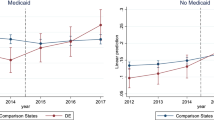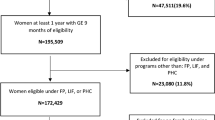Abstract
Background
Women experiencing unintended and short-interval pregnancies are at increased risk for adverse outcomes. Nationally, researchers report disparities in women’s use of effective contraceptive methods based on demographic, cultural, financial and system-level factors. Despite 58% of Louisiana births being unplanned, researchers have not reported on these relationships in Louisiana.
Methods
We used Louisiana Pregnancy Risk Assessment Monitoring System data from 2015 to 2018. Among postpartum women who were not abstinent, pregnant, or trying to become pregnant, we estimated use of five categories of effective contraception versus no effective method. We used multivariable multinomial logistic regression to investigate the association between effective contraceptive use and race/ethnicity, postpartum insurance and education.
Results
Among Louisiana postpartum women who were not abstinent, pregnant, or trying to become pregnant, 35.4% were not using effective contraception. Women with public insurance had greater odds of using long-acting reversible contraception than women with private insurance (adjusted odds ratio [AOR] 1.55; 95% confidence interval [CI] 1.11–2.16). Compared to women with a bachelor’s or higher, women with less than high school (AOR 2.09; CI 1.22–3.56), high school (AOR 3.11; CI 2.01–4.82) or some college education (AOR 2.48; CI 1.64–3.75) had greater odds of using permanent contraception. Black (AOR 3.83; CI 2.66–5.54) and Hispanic (AOR 3.85; CI 2.09–7.11) women, women with less than high school (AOR 6.79; CI 2.72–16.94), high school (AOR 7.26; CI 3.06–17.21) and some college (AOR 7.22; CI 3.14–16.60), and women with public insurance (AOR 1.91; CI 1.28–2.87) had greater odds of using injectable contraception.
Discussion
Results showed variation in effective contraceptive method use by race/ethnicity, insurance and education. These findings highlight the need for state-level research into the individual, provider, and policy-level factors that influence women’s contraceptive choices.
Similar content being viewed by others
References
American Psychological Association. (2019). Education and socioeconomic status. Washington, DC: American Psychological Association.
Byrd, J. E., Hyde, J. S., DeLamater, J. D., & Plant, A. E. (1998). Sexuality during pregnancy and the year postpartum. Journal of Family Practice, 47(4), 305–309.
Centers for Disease Control and Prevention. (2019). PRAMS—for researchers, October 23. PRAMS. Retrieved March 30, 2020, from https://www.cdc.gov/prams/prams-data/researchers.htm.
Centers for Disease Control and Prevention. (n.d.). Effectiveness of family planning methods. Centers for Disease Control and Prevention. Retrieved March 30, 2020, from https://www.cdc.gov/reproductivehealth/contraception/unintendedpregnancy/pdf/Contraceptive_methods_508.pdf.
Colman, G. J., & Joyce, T. (2003). Trends in smoking before, during, and after pregnancy in ten states. American Journal of Preventive Medicine, 24(1), 29–35.
Conde-Agudelo, A., & Belizán, J. M. (2000). Maternal morbidity and mortality associated with interpregnancy interval: Cross sectional study. BMJ, 321(7271), 1255–1259.
Conde-Agudelo, A., Rosas-Bermúdez, A., & Kafury-Goeta, A. C. (2006). Birth spacing and risk of adverse perinatal outcomes. JAMA, 295(15), 1809–1823.
Crutzen, R., & Göritz, A. S. (2010). Social desirability and self-reported health risk behaviors in web-based research: Three longitudinal studies. BMC Public Health, 10, 720.
Daniels, K., Daugherty, J., Jones, J., & Mosher, W. (2015). Current contraceptive use and variation by selected characteristics among women aged 15–44: United States, 2011–2013. Hyattsville, MD: National Health Statistics Reports.
Dehlendorf, C., Ruskin, R., Grumbach, K., Vittinghoff, E., Bibbins-Domingo, K., Schillinger, D., et al. (2010). Recommendations for intrauterine contraception: A randomized trial of the effects of patients’ race/ethnicity and socioeconomic status. American Journal of Obstetrics and Gynecology, 203(4), 319.e1–319.e8.
Dozier, A. M., Nelson, A., Brownell, E. A., Howard, C. R., & Lawrence, R. A. (2014). Patterns of postpartum depot medroxyprogesterone administration among low-income mothers. Journal of Women's Health, 23(3), 224–230.
Fiscella, K., Goodwin, M. A., & Kurt, S. (2002). Does patient educational level affect office visits to family physicians? Journal of the National Medical Association, 94(3), 157–165.
Gomez, A. M., Arteaga, S., Ingraham, N., Arcara, J., & Villaseñor, E. (2018). It’s not planned, but is it okay? The acceptability of unplanned pregnancy among young people. Womens Health Issues, 28(5), 408–414.
Hoff, G. L., Okah, F. A., Cai, J., & Liu, Y. (2012). Smoking during pregnancy rates trends in a high smoking prevalence state, 1990–2009. Europe PMC, 105(12), 636–644.
Largent, M. A. (2011). Breeding contempt: The history of coerced sterilization in the United States. New Brunswick, NJ: Rutgers University Press.
Louisiana Department of Health. (2019a). Louisiana PRAMS data report 2018. New Orleans, LA: Louisiana Department of Health. Retrieved March 30, 2020, from https://partnersforfamilyhealth.org/wp-content/uploads/2018/12/2018PRAMSDataReport_9.4.2019_Final.pdf.
Louisiana Department of Health. (2019b). Region 1 Parish, Louisiana 2015–2017 maternal and child health profile. New Orleans, LA: Louisiana Department of Health. Retrieved March 30, 2020, from https://ldh.la.gov/assets/oph/Center-PHCH/Center-PH/maternal/IndicatorProfiles/Region1Parishes_15-17/Region1_2015-2017.pdf.
Louisiana Bureau of Family Health. (n.d.). Louisiana pregnancy risk assessment monitoring system (Louisiana PRAMS). New Orleans, LA: Louisiana Department of Health. Retrieved March 30, 2020, from https://ldh.la.gov/index.cfm/page/1344.
Mauldon, J. G. (2003). Providing subsidies and incentives for norplant, sterilization and other contraception: Allowing economic theory to inform ethical analysis. The Journal of Law, Medicine and Ethics, 31, 351–364.
McKinney, D., House, M., Chen, A., Muglia, L., & Defranco, E. (2017). The influence of interpregnancy interval on infant mortality. American Journal of Obstetrics and Gynecology, 216(3), 316.e1–316.e9.
Okoroh, E. M., Kane, D. J., Gee, R. E., Kieltyka, L., Frederiksen, B. N., Baca, K. M., et al. (2018). Policy change is not enough: engaging provider champions on immediate postpartum contraception. American Journal of Obstetrics and Gynecology, 218(6), 590.e1–590.e7.
Orr, A. J. (2003). Black-White differences in achievement: The importance of wealth. Sociology of Education, 76(4), 281–304.
Reilly, P. R. (1987). Involuntary sterilization in the United States: A surgical solution. The Quarterly Review of Biology, 62, 153–170.
Robbins, C., Boulet, S. L., Morgan, I., D'Angelo, D., Zapata, L., Morrow, B., et al. (2018). Disparities in preconception health indicators—Behavioral Risk Factor Surveillance System, 2013–2015, and Pregnancy Risk Assessment Monitoring System, 2013–2014. MMWR Surveillance Summaries, 67(1), 1–16.
Schmidt, M. D., Pekow, P., Freedson, P. S., Markenson, G., & Chasan-Taber, L. (2006). Physical activity patterns during pregnancy in a diverse population of women. Journal of Women's Health, 15(8), 909–918.
Terplan, M., Hand, D., Hutchinson, M., Salisbury-Afshar, E., & Heil, S. (2015). Contraceptive use and method choice among women with opioid and other substance use disorders: A systematic review. Preventive Medicine, 80, 23–31.
Trussell, J. (2011). Contraceptive failure in the United States. Contraception, 83, 397–404.
Volscho, T. (2011). Racism and disparities in women’s use of the depo-provera injection in the contemporary USA. Critical Sociology, 35(5), 673–688.
Wachino, V. (2016). State medicaid payment approaches to improve access to long-acting reversible contraception. Baltimore, MD: Department of Health and Human Services.
White, K., Potter, J. E., Hopkins, K., & Grossman, D. (2014). Variation in postpartum contraceptive method use: Results from the Pregnancy Risk Assessment Monitoring System (PRAMS). Contraception, 89(1), 57–62.
Willems, S., De Maesschalck, S., Deveugele, M., Derese, A., & De Maeseneer, J. (2005). Socio-economic status of the patient and doctor–patient communication: Does it make a difference? Patient Education and Counseling, 56(2), 139–146.
Acknowledgements
We would like to acknowledge the Louisiana Department of Health, Bureau of Family Health staff who provided feedback throughout the early development of this project, including Rosaria Trichilo, Jennifer Le, Randal Leggett, Norah Friar, and Katie Sacca Brennan. We would also like to acknowledge Amy Zapata and Jane Herwehe for their revisions of the final manuscript. Finally, we thank the women of Louisiana who participated in the PRAMS survey. This project was supported in part by an appointment to the Applied Epidemiology Fellowship Program administered by the Council of State and Territorial Epidemiologists (CSTE) and funded by the Centers for Disease Control and Prevention (CDC) Cooperative Agreement Number 1 NU38OT000297-01-00.
Author information
Authors and Affiliations
Corresponding author
Additional information
Publisher's Note
Springer Nature remains neutral with regard to jurisdictional claims in published maps and institutional affiliations.
Rights and permissions
About this article
Cite this article
Bruce, K., Benno, J. & Kieltyka, L. Variation in Postpartum Use of Most and Moderately Effective Contraceptive Methods Among Louisiana Women. Matern Child Health J 24, 1151–1160 (2020). https://doi.org/10.1007/s10995-020-02971-x
Published:
Issue Date:
DOI: https://doi.org/10.1007/s10995-020-02971-x




